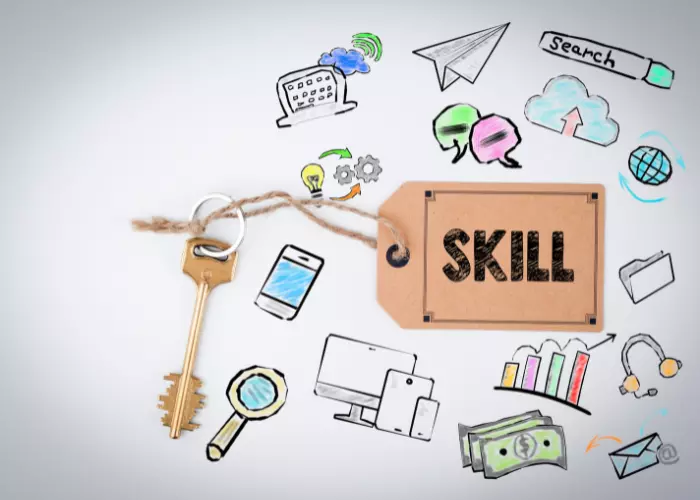Skills Gap: Why Nearly Half of Workers Need Upgrading

The skills gap, which predates the COVID-19 pandemic, has become more pronounced with technological advancements shaping a dynamic job market. As industries evolve, the need for individuals to adapt to the digital era has intensified.
This blog delves into the intricacies of the skills gap, exploring its impact on individuals, businesses, and industries. Additionally, it scrutinises sectors experiencing shortages and analyses the specific skills demanded by the job market. Insights into addressing the challenges posed by the skills gap are provided, emphasising the importance of continuous learning, strategic workforce planning, and upskilling.
Artificial intelligence (AI) is revolutionizing the way industries function, making it imperative for individuals to embrace artificial intelligence (AI) technology and enhance their skill set through upskilling programs. To counter the negative effects of the skills gap, organizations must prioritize workforce development initiatives that equip employees with the necessary skills to thrive in an AI-powered world.
These initiatives should focus on bridging the gap between current skill sets and the evolving demands of the job market. By investing in AI-driven workforce development, businesses can ensure their workforce remains competitive and adaptable, facilitating continued growth and innovation.
Jump To Section

Earn As You Learn
Earn 25% commission when your network purchase Uplyrn courses or subscribe to our annual membership. It’s the best thing ever. Next to learning,
of course.
The Skills Gap: A Mismatch Between Job Requirements and Workforce Skills
The term "skills gap" refers to the discrepancy between the skills needed for a specific job and the skills possessed by the workforce. This mismatch can result in individuals being either underqualified or overqualified for their roles. Startling estimates suggest that by 2030, approximately 20% of the workforce could face significant under-skilling, which poses threats to both productivity and employability.
For businesses, the skills gap presents challenges such as productivity loss, higher turnover rates, and lower-quality work. At the industry level, talent shortages can be widespread, affecting positions that require both high and low levels of skill.
Existence and Causes of the Skills Gap
Debates surround the severity of the skills gap, with some arguing its existence and others claiming it to be a myth. However, evidence strongly indicates its presence, particularly in industries experiencing rapid technological transformations.
The rise of disruptive technologies, such as artificial intelligence (AI) and automation, plays a pivotal role in shaping the job market. These innovations render certain roles obsolete while creating new demands for emerging skills, creating a significant AI skills gap. The shift in employer expectations towards hiring job-ready individuals, coupled with a decline in apprenticeships, further contributes to the skills gap.
Education also emerges as a crucial factor in the skills gap equation. Despite high overall education levels, gaps in basic skills like literacy and numeracy persist. The fast-paced nature of technological advancement necessitates continuous learning, yet only a fraction of the workforce engages in reskilling and upskilling initiatives. Moreover, the gig economy and the pressure for instant results have altered the hiring landscape. Companies increasingly seek individuals who are job-ready, valuing experience over potential.
Industries Affected by the Skills Gap
Various reports and resources provide insights into industries grappling with significant skills shortages. The Project Luminate report explores the reasons some vacancies are challenging to fill and examines the labour market regionally.
The UK Skills Mismatch in 2030 report focuses on the skills themselves, highlighting major problems in basic digital skills, AI skills, leadership, and management. The shortage of skilled professionals is particularly acute in STEM fields (science, technology, engineering, and mathematics), healthcare, IT, the creative sector, and trade. Specific roles, such as nurses, programmers with AI skills, HR officers, IT user support technicians, business sales executives, engineers, design and development engineers, web designers, and chartered accountants, consistently face shortages. These trends echo in the US job market, emphasising the global nature of the skills gap.
In-Demand Skills
Employers seek a balanced combination of hard and soft skills, recognizing that a holistic skill set contributes to overall workplace success. Hard skills, which are measurable and teachable abilities, are consistently in demand across various industries. Blockchain expertise is sought after due to its applications beyond cryptocurrencies, impacting sectors like finance and supply chain management. Cloud computing skills are crucial as businesses increasingly rely on cloud-based solutions for flexibility and efficiency. Analytical reasoning, applicable in fields like data analytics and strategic thinking, is vital for processing and interpreting large sets of data.
The ongoing developments in artificial intelligence (AI) have opened new possibilities, making AI proficiency a sought-after skill. The field of UX design, focusing on creating user-friendly digital experiences, is gaining prominence as digital products become integral to modern life. These hard skills, including AI skills, reflect the evolving technological landscape and the need for professionals who can navigate and contribute to these advancements.
Soft skills, on the other hand, represent the interpersonal and personality traits that contribute to effective collaboration and leadership. Creativity, the ability to approach problems imaginatively, is valued across industries for innovation. Persuasion skills become crucial in negotiation and leadership roles, influencing others to align with ideas. Collaboration is an essential soft skill, emphasizing effective teamwork for achieving organizational goals. Adaptability is increasingly valued in a rapidly changing work environment, highlighting the importance of individuals who can navigate new situations with ease. Emotional intelligence, understanding and responding to emotions, is recognized as a critical soft skill for building positive workplace relationships.
Overcoming Hurdles in Tackling the Skills Gap
Workplace Perspective
Developing the infrastructure necessary for strategic workforce planning poses a challenge for organizations. Many companies prioritize hiring individuals who can immediately fill gaps rather than investing in long-term development. The pressure for instant results, combined with the rapidly changing workplace, further complicates workforce planning.
Individual Perspective
For individuals, the challenge lies in training or retraining. This process not only requires dedicating time and effort to learn new skills but also demands careful consideration of the right progression path. The uncertainty surrounding future job market demands and technological advancements adds another layer of complexity.
Decline in Apprenticeships
The decline in apprenticeships globally contributes to these challenges. In previous generations, employers would hire graduates or untrained newcomers and train them on the job. However, with the gig economy gaining prominence, many companies now seek individuals who are job-ready. Experience is often valued more than potential, and expectations and requirements reflect this shift in hiring practices.
Funding Constraints
Furthermore, funding constraints limit the opportunities for individuals to engage in vocational education and training, exacerbating the skills gap. These challenges create a complex landscape that requires innovative solutions from both employers and individuals.
How Businesses Respond to the Skills Gap
Industry Experts Highlight the Prevalence of the Skills Gap in a Global Context
According to a recent global survey by McKinsey, 87% of organizations are currently experiencing or expect to experience a skills gap in the next few years. This acknowledgment prompts organizations to explore effective strategies to address the problem.
Conducting a Skills Gap Analysis
A crucial step in this process is conducting a skills gap analysis. Organizations need to examine the essential skills they require and compare them to the skills their workforce currently possesses. This analysis provides valuable insights for HR teams, enabling them to identify areas of deficiency and formulate targeted strategies.
Hiring as a Strategic Tool
Hiring becomes a strategic tool in addressing the skills gap. With a comprehensive skills gap analysis, companies can prioritize hiring individuals with the right skills. Instead of focusing on roles with a narrow scope, they can strategically target areas where the organization currently lacks expertise, thereby improving the overall skill pool.
Skill Building: Bridging the Skills Gap
Skill building has emerged as the most effective way to bridge the skills gap. Companies can actively engage in offering reskilling and upskilling programs to their existing employees. These programs help individuals acquire the skills that the organization lacks, fostering a culture of continuous learning within the workforce. By investing in the development of their employees, companies not only bridge immediate skills gaps but also cultivate a skilled and adaptable workforce for the future.
Closing the Skills Gap: Individual Strategies
While companies play a pivotal role in addressing the skills gap, individuals also have a crucial role to play in navigating and bridging this divide. Taking proactive steps to assess, address, and enhance personal AI skills can significantly contribute to employability and career growth.
Self-assessment: The first step for individuals is to conduct a thorough self-assessment of their existing skills, e.g. AI skills. This involves identifying personal strengths and weaknesses and understanding how these factors impact career prospects. Comparing current AI skills to those outlined in job postings for desired roles provides clarity on any existing gaps in knowledge or proficiency.
Address the shortages: Once individuals identify their skill gaps, they can take proactive steps to address them. This could involve undertaking AI training programs through their current employers, participating in online AI courses, or pursuing formal education. The goal is to enhance the skill set, making it more aligned with the demands of the evolving job market. Various learning opportunities, from short online courses to more extended educational experiences, are available to individuals looking to upskill or reskill.
Gaining experience: In addition to enhancing skills through education and training, gaining relevant experience is crucial. However, the challenge often lies in the catch-22 situation where experience is required for a job, but jobs require prior experience. Overcoming this hurdle involves exploring alternative paths, such as freelancing as a side gig, participating in internships or apprenticeships, and even volunteering. These experiences not only contribute to skill development but also provide tangible examples of one's abilities.
Knowing how to market yourself: Effectively marketing oneself is a crucial aspect of closing the skills gap from an individual perspective. Knowing how to craft a strong resume that highlights relevant skills and experiences is essential. Additionally, honing interview skills and effectively communicating how one's skills can contribute to an organisation's success enhances the likelihood of securing desired positions. It's about demonstrating not only what skills one possesses but also how those skills can fulfil the needs of potential employers.
Lifelong learning: Embrace the concept of lifelong learning. Stay informed about industry trends, AI technological advancements, and evolving job requirements. Engage in continuous learning to remain adaptable and ready for the changing demands of the job market.
Networking: Build a professional network to stay connected with industry trends and opportunities. Networking provides insights into the skills in demand and opens doors to potential collaborations or job opportunities.
Mentorship: Seek mentorship from experienced professionals in your field. Mentors can offer guidance, share industry insights, and help navigate career paths, contributing to both personal and professional growth.
Adaptability mindset: Cultivate an adaptability mindset. Recognize that the job market is dynamic, and being adaptable to change is a valuable skill. Embrace challenges as opportunities for growth and learning.
Conclusion
The skills gap is a complex challenge that requires collaboration between employers and individuals. As the job market evolves due to technological advancements, continuous learning and adaptability are essential. While industries struggle with talent shortages, individuals can navigate the skills gap by assessing their capabilities, addressing deficiencies, gaining experience, and effectively marketing themselves.
Bridging the skills gap is an ongoing process that requires a proactive approach from both sides. Companies have a crucial role to play in strategic hiring, investing in workforce development, and offering reskilling programs. At the same time, individuals can take control of their career paths by embracing lifelong learning, staying informed, and cultivating a diverse skill set.
Navigating the complexities of the skills gap is not without challenges, but with a proactive mindset and a commitment to continuous improvement, both individuals and organizations can thrive in the ever-changing job market.


Leave your thoughts here...
All Comments
Reply